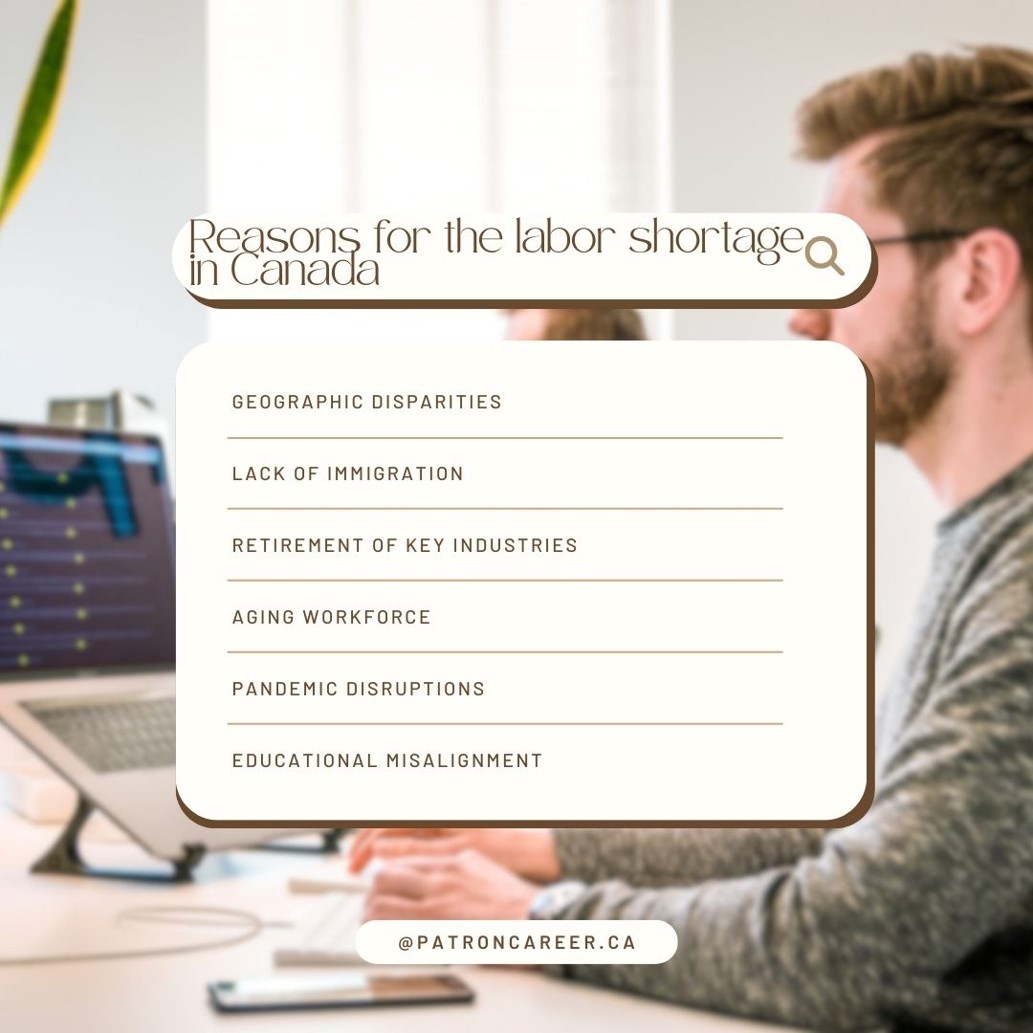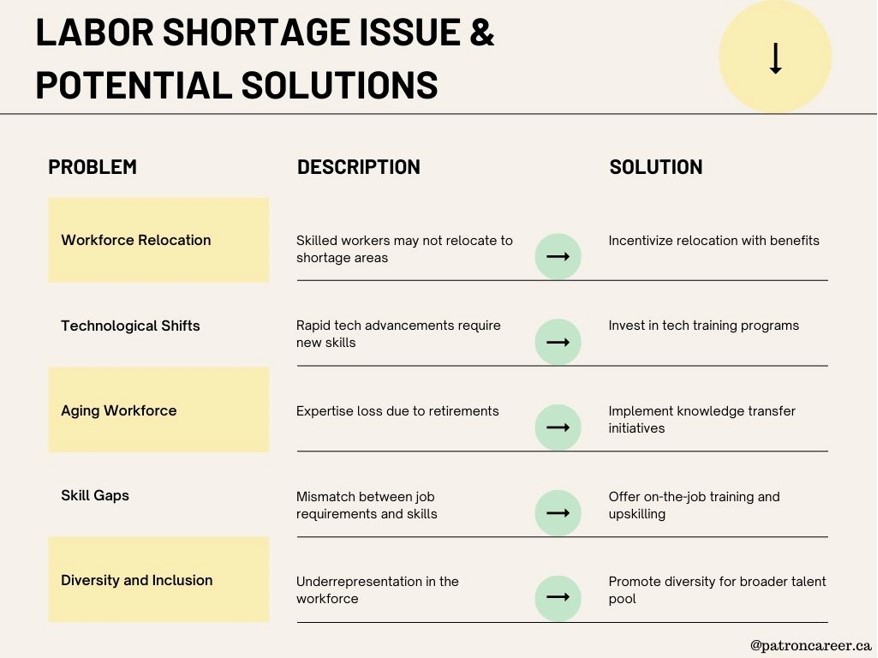
Transform Your Company Culture
06 September, 2023
Patron Career Staffing firmly believes in adopting a tailored approach to meet temporary and permanent recruitment needs. We safeguard the interest of our clients by finding such workers who are knowledgeable and reliable.
About UsNeed help? Make a Call
32 Dundas Street East Unit A, L5A1W2

Abstract: In 2023, Canada is facing a paradigm shift in its labour landscape, marked by a persistent labour shortage. This article delves into the reasons behind this phenomenon, including an aging workforce, pandemic-related disruptions, and demographic shifts. It also explores proactive strategies for businesses to stay competitive and attract skilled workers in this challenging environment. From embracing technology and offering competitive compensation to collaborating with educational institutions and promoting inclusivity, we examine how organizations can thrive amidst the labour shortage. Join us in deciphering the Canadian labour market's "new normal" and discovering opportunities for growth and resilience.
Canada has been dealing with a slowdown in work and economic activity per se. Though known illustriously for its diverse cultures, stunning landscapes and strong economy, it has been grappling with a detrimental challenge- a labour shortage. Several Canadian industries such as Hospitality, Trucking, Health Care, Manufacturing and Construction are currently on the verge of an economic maelstrom. Even after offering more incentives such as bonuses, remote work options and higher pay to seasoned and full-time workers, they are still capable of curbing this tragic disruption in the tight labour market of Canada.
This pressing issue already has been magnified owing to multitudinous factors, including the ageing workforce, the pandemic's disruptions, and changing demographics. In this article, we'll explore the meaning of labour shortage, its impact on businesses, and strategies to attract skilled shift workers while staying competitive.
Understanding the Labor Shortage
A labour shortage is not a new concept, but its recent severity in Canada has brought it to the vanguard. This shortage has been particularly pronounced in sectors like healthcare, technology, construction, and agriculture, where skilled workers are in high demand. A labour shortage is a scenario that occurs when the number of jobs exceeds the number of workers available to perform those jobs. This is the simplest definition to ideate the ongoing problem that Canadian businesses are facing.
To overcome and speed up the industrial process, dodging a helping hand might not be the right move to make. You need help and PCS is here to assist you. Read on, because will provide you with additional tips to get you up and started and have your business attract more manpower.
Key Factors Contributing to The Labour Shortage in Canada Include:

1. Aging Workforce: The baby boomer generation is retiring, leaving gaps in the labour market that are challenging to fill.
2. Pandemic Disruptions: COVID-19 disrupted industries and labour markets, causing uncertainty and hesitancy among workers to return to certain jobs.
3. Demographic Shifts: Canada's birth rate has been declining, contributing to a smaller pool of young workers.
4. Skills Mismatch: There's often a gap between the skills employers need and the skills workers possess, leading to a shortage of qualified candidates.
5. Geographic Disparities: Labor shortages are more pronounced in certain regions, where job opportunities may not align with the workforce's location.
Now that we've identified the problem, let's delve into strategies for Canadian businesses to tackle this acute labour shortage.

Staying Competitive and Attracting Skilled Shift Workers
1. Invest in Training and Development: Instead of solely relying on external hiring, businesses can invest in their current workforce. Developing training programs can help employees acquire new skills and adapt to changing job roles within the company.
2. Amp up Technology: Automation and digital tools can help companies streamline operations, reduce labour requirements, and improve efficiency. This not only makes the workplace more attractive but also positions the business as forward-thinking.
3. Offer Competitive Compensation: Competitive compensation packages, including salaries, benefits, and incentives, can be a significant draw for skilled workers. Conducting regular market research ensures your offerings remain competitive within your industry.
4. Flexible Working Arrangements: Flexibility in work arrangements, such as remote work options or flexible scheduling, has become increasingly important to employees. Offering such flexibility can make your organization more appealing to a wider range of candidates.
5. Collaborate with Educational Institutions: Partnering with local colleges and universities to create programs that align with your industry's needs can be a proactive way to address the skills gap. This ensures that graduates are better prepared for the job market.
6. Engage in Immigration Programs: Canada has various immigration programs designed to attract skilled workers from other countries. Businesses can tap into these programs to fill positions that are challenging to fill locally.
7. Promote Inclusivity: Building a diverse and inclusive workplace culture not only fosters a sense of belonging but also attracts talent from a wider range of backgrounds and experiences.
8. Streamline Recruitment Processes: Efficiency in the hiring process is crucial, especially when trying to fill positions quickly. Modern applicant tracking systems (ATS) and digital recruitment platforms can help streamline recruitment efforts.
9. Engage with Staffing Agencies: Temporary or contract workers can help bridge the gap during labour shortages. Collaborating with staffing agencies can provide access to a flexible workforce.
10. Invest in Employee Retention: Once you've attracted skilled workers, it's important to retain them. Career development opportunities, recognition programs, and creating a positive work environment are essential for keeping your employees satisfied and committed to your organization.
Related: Workplace Diversity
Conclusion
The labour shortage in Canada is a complex issue with far-reaching implications. However, it's also an opportunity for businesses to innovate, adapt, and emerge stronger. By investing in your workforce, offering competitive incentives, and leveraging technology, you can navigate this challenge successfully. Remember, the key is not only to attract skilled shift workers but also to retain them through a supportive and inclusive workplace culture. As Canada faces this labour shortage, forward-thinking businesses will find ways to thrive and contribute to the nation's prosperity.
